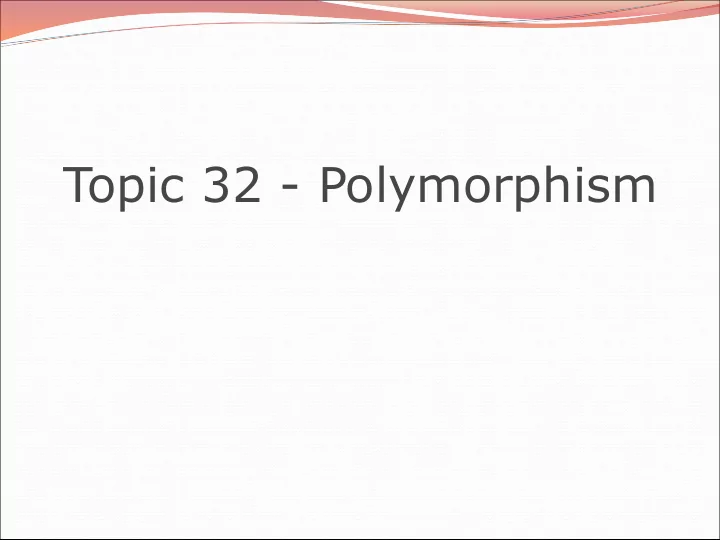

Topic 32 - Polymorphism
Clicker 1 What is output by the following code? Critter c1 = new Hippo(7); System.out.print(c1.toString()); A. 7 B. ? C. null D. No output due to a syntax error E. No output due to a runtime error 2
Polymorphism polymorphism : Ability for the same code to be used with different types of objects and behave differently with each. System.out.println can print any type of object. Each one displays in its own way on the console. CritterMain can interact with any type of critter. Each one moves, fights, etc. in its own way . 3
Coding with polymorphism A variable of type T can refer to an object of any subclass of T . Critter c1 = new Hippo(7); You can call any methods from the Critter class on c1 . When a method is called on c1 , it behaves as a Hippo . System.out.println( c1.getColor ); // GRAY System.out.println( c1.toString() ); // 7 4
Polymorphism and parameters You can pass any subtype of a parameter's type. public class CriiterMain { public static void main(String[] args) { Hippo henry = new Hippo(7); Bird angry = new Bird(); printInfo(henry); printInfo(angry); } public static void printInfo( Critter crit ) { System.out.println(" eat?: " + crit.eat()); System.out.println(" fight: " + crit.fight("?")); System.out.println(" move: " + crit.getMove()); System.out.println(); } } 5 OUTPUT???
Polymorphism and arrays Arrays of superclass types can store any subtype as elements. public class CritterMain2 { public static void main(String[] args) { Critter[] crits = { new Bird(), new Vulture(), new Hippo(7), new Ant(true) }; for (int i = 0; i < crits.length; i++) { System.out.println(" color: " + crits[i].getColor() ); System.out.println(" move: " + crits[i].getMove() ); System.out.println(); } } } Output: 6
A polymorphism problem public class Baz extends Foo { public class Foo { public void method1() { public void method1() { System.out.println("baz 1"); } System.out.println("foo 1"); } public String toString() { return "baz"; public void method2() { } } System.out.println("foo 2"); } public class Mumble extends Baz { public void method2() { public String toString() { System.out.println("mumble 2"); return "foo"; } } } } public class Bar extends Foo { public void method2() { System.out.println("bar 2"); } } 7
A polymorphism problem } What would be the output of the following client code? Foo[] foos = {new Baz(), new Bar(), new Mumble(), new Foo()}; for (int i = 0; i < foos.length; i++) { System.out.println( foos[i] ); foos[i].method1(); foos[i].method2(); System.out.println(); } 8
Diagramming the classes Add classes from top (superclass) to bottom (subclass). Include all inherited methods. 9
Finding output with tables method method method Foo Foo Foo Bar Bar Bar Baz Baz Baz Mumble Mumble Mumble method1 method1 foo 1 foo 1 baz 1 baz 1 method1 foo 1 baz 1 method2 method2 method2 foo 2 foo 2 bar 2 bar 2 foo 2 mumble 2 mumble 2 toString toString foo foo baz baz toString foo baz 10
Polymorphism answer Foo[] foos = {new Baz(), new Bar(), new Mumble(), new Foo()}; for (int i = 0; i < foos.length; i++) { System.out.println(foos[i]); foos[i].method1(); foos[i].method2(); System.out.println(); } Output: baz baz 1 foo 2 foo foo 1 bar 2 baz baz 1 mumble 2 foo foo 1 foo 2 11
Another problem The order of the classes is jumbled up. The methods sometimes call other methods (tricky!). public class Lamb extends Ham { public void b() { System.out.print("Lamb b "); } } public class Ham { public void a() { System.out.print("Ham a "); b(); } public void b() { System.out.print("Ham b "); } public String toString() { return "Ham"; } } 12
Another problem 2 public class Spam extends Yam { public void b() { System.out.print("Spam b "); } } public class Yam extends Lamb { public void a() { System.out.print("Yam a "); super.a(); } public String toString() { return "Yam"; } } What would be the output of the following client code? Ham[] food = {new Lamb(), new Ham(), new Spam(), new Yam()}; for (int i = 0; i < food.length; i++) { System.out.println( food[i] ); food[i].a(); System.out.println(); // to end the line of output food[i].b(); System.out.println(); // to end the line of output System.out.println(); } 13
Class diagram 14
Polymorphism at work Lamb inherits Ham 's a . a calls b . But Lamb overrides b ... public class Ham { public void a() { System.out.print("Ham a "); b(); } public void b() { System.out.print("Ham b "); } public String toString() { return "Ham"; } } public class Lamb extends Ham { public void b() { System.out.print("Lamb b "); } } Lamb 's output from a : Ham a Lamb b 15
The table method method method Ham Ham Ham Lamb Lamb Lamb Yam Yam Yam Spam Spam Spam a a a Ham a Ham a Ham a Yam a Yam a Yam a b() b() b() Ham a Ham a Ham a b() b() b() b b b Ham b Ham b Lamb b Lamb b Lamb b Spam b Spam b toString toString toString Ham Ham Ham Yam Yam Yam 16
The answer Ham[] food = {new Lamb(), new Ham(), new Spam(), new Yam()}; for (int i = 0; i < food.length; i++) { System.out.println(food[i]); food[i].a(); food[i].b(); System.out.println(); } Output: Ham Ham a Lamb b Lamb b Ham Ham a Ham b Ham b Yam Yam a Ham a Spam b Spam b Yam Yam a Ham a Lamb b Lamb b 17
Overriding Object's equals Method The Object class contains this method: public boolean equals(Object obj) many classes override this method many students mistakenly overload the method many headaches when placing objects in data structures 18
Overriding Object's equals Method overriding equals correctly follows a pattern So, it isn't that hard, if you follow the pattern Override equals for a Standard Playing Card Override equals for a Snake Critter Demo array of Critter objects 19
Recommend
More recommend